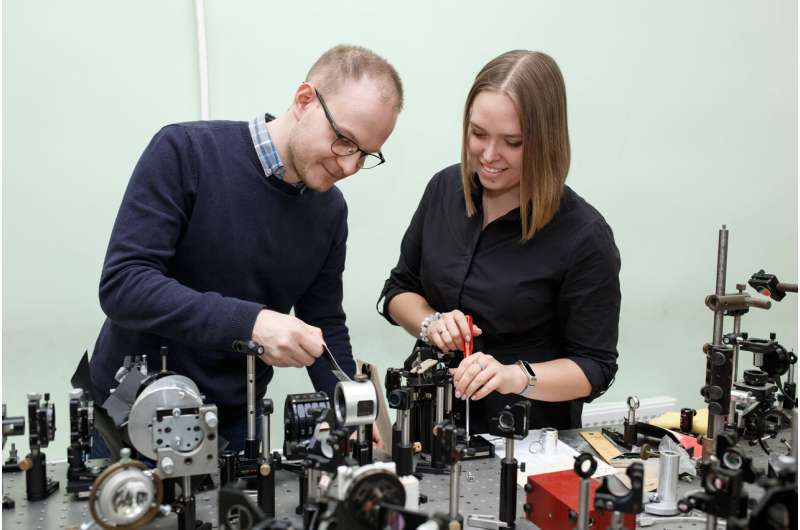Authors of the research: Maxim Melnik and Maria Zhukova. Credit: ITMO University
Scientists from ITMO University for the first time in the world managed to directly measure the nonlinear refractive index of matter in the terahertz range. The results of the experiments were compared with previous theoretical predictions to confirm the presence of nonlinear effects. The obtained data can be used to control light, as well as in fundamental and biomedical research. The results are published in Optics Express.
Over the past 40 years, terahertz radiation has found widespread use for quality control and safety systems, for substances determination, as well as for various biomedical research. However, high-power radiation sources in this range appeared relatively recently. Such powerful radiation changes the refractive index of the medium and affects how it transmits radiation from other ranges. Researchers call such effects nonlinearities and study them to create devices for controlling light.
For the first time in the world, the scientists from ITMO University directly measured the nonlinear refractive index of matter in the terahertz range. They adapted the previously known Z-scan method to obtain experimental data on how high-power radiation changes the refractive index of the sample. After that the researchers conducted a numerical simulation of the experiment and compared the results: they turned out to be similar.
"For the first time, we managed to reliably verify that terahertz radiation causes strong nonlinearity in the medium. So far, we conducted measurements only for water, but we plan to expand the range of media to perform experimental and theoretical studies of this kind. The data obtained will be useful for creating devices for light control, as well as for fundamental and biomedical research," commented Maria Zhukova, member of the Laboratory of Femtosecond Optics and Femtotechnologies at ITMO University.
"Our laboratory has long been engaged in the development of high-intensity terahertz radiation sources, and we have already achieved some outstanding results. But before going deep into the fundamental aspects of it, we decided to describe the nonlinearities it causes using rare equipment at ITMO University. We adapted the method for measuring nonlinearity in order to use existing experimental base as efficiently as possible," adds Maksim Melnik from the Laboratory of Femtosecond Optics and Femtotechnologies at ITMO University.
More information: Anton N. Tcypkin et al. High Kerr nonlinearity of water in THz spectral range, Optics Express (2019). DOI: 10.1364/OE.27.010419
Journal information: Optics Express
Provided by ITMO University























